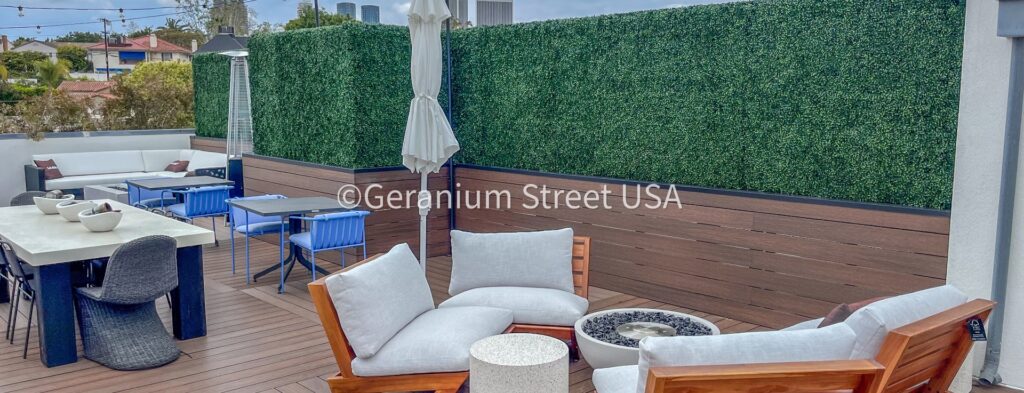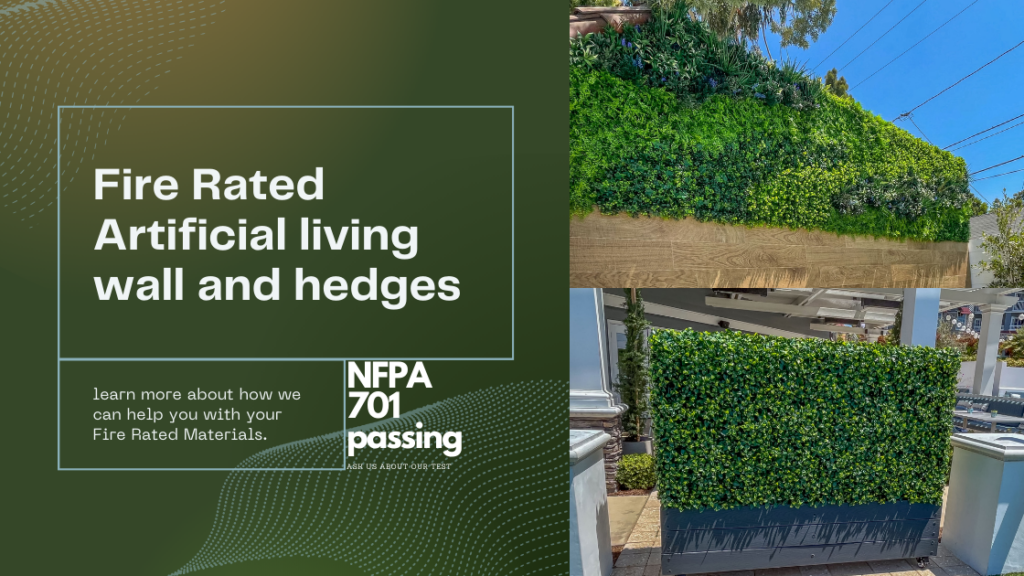In the world of modern design and landscaping, artificial greenery has become increasingly popular for its low maintenance and year-round aesthetic appeal. However, with this rise in popularity comes a crucial consideration: fire safety. As we incorporate artificial fire-rated ficus leaf mats and other synthetic foliage into our spaces, understanding the importance of fire-rated hedges and the testing methods used to ensure their safety is paramount.
Key Points Table
| Point | Description |
|---|---|
| Safety Priority | Fire-rated hedges are crucial for public and private spaces |
| Test Comparison | UL94 vs. NFPA 701 Method 2 for artificial foliage |
| NFPA 701 Advantage | More comprehensive and reliable for real-world scenarios |
| Application Areas | Commercial, residential, and hospitality sectors |
| Product Range | Fire-retardant artificial solutions for various needs |
Introduction
The significance of fire safety in both public and private spaces cannot be overstated. From bustling commercial environments to cozy residential settings, the materials we choose to decorate and define our spaces must meet rigorous safety standards. This is where fire-rated artificial hedges come into play, offering a blend of aesthetic appeal and crucial safety features.
But not all fire safety tests are created equal. In this article, we’ll delve into the world of fire safety testing for artificial foliage, comparing two prominent methods: UL94 and NFPA 701 Method 2. We’ll explore why the National Fire Protection Association (NFPA) 701 test is considered superior and more comprehensive when it comes to evaluating the fire resistance of synthetic greenery.
“In the realm of fire safety, the right test can mean the difference between prevention and disaster.”
As we navigate through this topic, we’ll consider various applications, from events to permanent installations, and how different sectors approach fire safety with artificial greenery. Whether you’re a property manager, an event planner, or a homeowner considering the addition of artificial hedges to your space, understanding these testing methods will empower you to make informed decisions about the products you choose.
Let’s begin our exploration of why the test matters when it comes to fire-rated hedges and uncover what makes NFPA 701 Method 2 the gold standard in ensuring the safety of artificial foliage in our environments.
Certainly. Here’s the next part of the article:
The Battle of the Tests: UL94 vs. NFPA 701 Method 2
When it comes to fire safety testing for artificial foliage, two methods often come into the spotlight: UL94 and NFPA 701 Method 2. While both aim to assess fire resistance, their approaches and implications differ significantly. Understanding these differences is crucial for anyone involved in selecting fire retardant tested artificial solutions for various applications.
UL94: The Basics
UL94, developed by Underwriters Laboratories, is a set of flammability tests for plastic materials used in devices and appliances. This test primarily focuses on:
- Burning rate
- Time to extinguish
- Drip formation
While UL94 has its merits in certain applications, it falls short when it comes to comprehensive testing of larger artificial foliage installations. The test is conducted on small, standardized samples, which may not accurately represent the behavior of a full-sized artificial boxwood hedge mat in a real-world scenario.
NFPA 701 Method 2: A More Comprehensive Approach
The National Fire Protection Association’s 701 Method 2 test, on the other hand, offers a more robust and realistic assessment of fire safety for artificial greenery. Here’s why it’s considered superior:
- Large Sample Testing: NFPA 701 Method 2 uses larger artificial foliage samples, providing a more accurate representation of how artificial foliage would behave in an actual fire scenario.
- Vertical Flame Propagation: The test assesses how fire spreads vertically, which is crucial for wall-mounted or tall artificial hedges commonly used in commercial products.
- Afterflame Time: It measures how long the material continues to burn after the ignition source is removed, offering insight into the material’s self-extinguishing properties.
- Char Length: The test evaluates the extent of damage to the material, providing a clear picture of fire resistance.
- Flaming Debris: NFPA 701 Method 2 assesses whether the burning material produces flaming droplets, a critical factor in fire spread.
“NFPA 701 Method 2 simulates real-world fire scenarios more accurately, making it the preferred choice for ensuring the safety of artificial greenery in diverse settings.”
Why NFPA 701 Method 2 Matters More
For businesses in the hospitality sector and beyond, choosing NFPA 701 Method 2 tested products offers several advantages:
- Realistic Assessment: The test provides results that better reflect how artificial foliage would perform in an actual fire event.
- Comprehensive Data: It offers a more complete picture of fire resistance, including flame spread and material behavior.
- Regulatory Compliance: Many jurisdictions and building codes specifically require NFPA 701 testing for decorative materials.
- Peace of Mind: For property owners and managers, knowing that their artificial greenery has passed this rigorous test offers greater assurance of safety.
As we continue to integrate artificial greenery into our spaces, from artificial succulent mats to elaborate hedge walls, the importance of choosing products that have undergone NFPA 701 Method 2 testing cannot be overstated. This commitment to safety ensures that the beauty of our artificial landscapes doesn’t come at the cost of fire safety.
Real-World Applications and Implications
Understanding the superiority of NFPA 701 Method 2 testing is crucial, but how does this translate into real-world applications? Let’s explore the practical implications across various sectors and scenarios.
Commercial Spaces: Balancing Aesthetics and Safety
In commercial environments, the use of artificial greenery has become increasingly popular for its ability to create inviting, natural-looking spaces without the maintenance requirements of live plants. However, these settings often have stringent fire safety regulations.
- Office Buildings: Large-scale installations like living walls in lobbies or conference rooms must meet strict safety standards.
- Retail Spaces: Decorative elements, including artificial hedges, need to ensure customer safety without compromising on visual appeal.
- Restaurants: Artificial plants and dividers must adhere to fire codes while enhancing the dining atmosphere.
By choosing NFPA 701 Method 2 tested products, commercial property managers can confidently create green spaces that are both beautiful and compliant with safety regulations.
Residential Applications: Home Safety First
While residential spaces may have less stringent regulations, the importance of fire safety in the home cannot be overstated. Residential fire-retardant tested artificial solutions offer homeowners the ability to enhance their living spaces without compromising on safety.
- Indoor Decor: From artificial plants to green walls, NFPA 701 tested products provide peace of mind for indoor decorations.
- Outdoor Living Areas: Fire-rated artificial hedges and screens can create private, safe outdoor spaces.
- Apartment Complexes: Multi-unit residential buildings benefit from the added layer of safety in common areas and individual units.
Events and Temporary Installations
The events industry faces unique challenges when it comes to fire safety. Temporary installations must meet the same safety standards as permanent ones, often in diverse and challenging environments.
- Trade Shows: Exhibition booths with artificial greenery need to comply with venue fire safety regulations.
- Weddings and Parties: Decorative elements, including artificial floral arrangements, should not pose fire risks.
- Corporate Events: Temporary green walls and dividers must ensure attendee safety without sacrificing aesthetic appeal.
NFPA 701 Method 2 tested products provide event planners with versatile, safe options for creating stunning yet secure event spaces.
Conclusion: Prioritizing Safety Without Compromising on Style
As we’ve explored throughout this article, the choice of fire safety testing for artificial foliage is not just a technical detail—it’s a crucial decision that impacts the safety and compliance of spaces across various sectors. The superiority of NFPA 701 Method 2 testing lies in its comprehensive approach, providing a more realistic assessment of how artificial greenery would perform in actual fire scenarios.
By choosing products that have undergone this rigorous testing, property owners, designers, and event planners can:
- Ensure compliance with stringent safety regulations
- Provide safer environments for occupants and visitors
- Maintain aesthetic appeal without compromising on safety
- Have greater confidence in the fire-resistant properties of their artificial greenery
As the demand for low-maintenance, visually appealing spaces continues to grow, the importance of fire-rated artificial solutions becomes increasingly apparent. Whether it’s a fire-rated ficus leaf mat in a hotel lobby or an artificial boxwood hedge in a residential garden, choosing NFPA 701 Method 2 tested products ensures that safety remains at the forefront of design decisions.
In conclusion, as we continue to innovate and enhance our spaces with artificial greenery, let us not forget that true beauty lies not just in appearance, but in the peace of mind that comes with knowing our environments are as safe as they are stunning.
FAQ
What is the difference between UL94 and NFPA 701 Method 2 testing?
Why is NFPA 701 Method 2 considered better for testing artificial greenery?
Are fire-rated artificial hedges suitable for both indoor and outdoor use?
How often should fire-rated artificial greenery be replaced?
Can fire-rated artificial hedges be customized for specific spaces?




